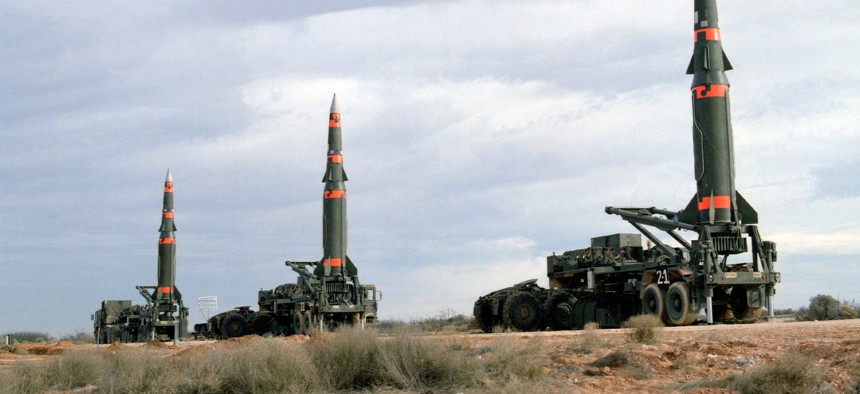
Several Pershing II missiles are prepared for launching at Fort Bliss McGregor Range in 1987. Frank Trevino / Department of Defense
Europe Has No Attractive Options in the Post-INF World
Soon to be back in the nuclear line of fire, Europeans wonder how to get arms control back on the international agenda.
Europeans remember the 1980s, when the United States and Russia quickly built up a combined arsenal of nearly 3,500 nuclear-armed medium-range missiles, all aimed at Europe. The likely end of the Intermediate-range Nuclear Forces Treaty on Aug. 2 leaves the continent with a straightforward strategic consideration: persuade the U.S. and Russia to return arms control, or find itself once again in the nuclear line of fire. Yet there is no clear path ahead.
Russia clearly has no interest in the INF. For more than a decade, Moscow has been spending considerable amounts of money to improve the SSC-8 ground launch cruise missile, explicitly breaching the treaty in 2014 by deploying SSC-8s near Yekaterinburg and at the Kapustin Jar test site in the Caspian region. Such medium-range missiles are also fully integrated in Russia’s “active measures” doctrine that aims to destabilize opponents with a combination of conventional, hybrid, and nuclear forces. Russian leaders also fear that the expansion of U.S. missile defenses in Europe and Asia could undermine their nuclear second-strike capability, and thus their independence. Cruise missiles offer a cheap, reliable, quick-striking way to eliminate U.S. missile defenses.
Nor is the United States much interested, at least during a Trump administration that believes that the limits imposed by the INF and other arms-control treaties do the United States more harm than good. “There is no reason the United States should continue to cede the crucial military advantage to revisionist powers,” Secretary of State Mike Pompeo said at NATO headquarters in December. So the United States is working on a new sub-launched nuclear cruise missile, a move it principally justifies as a way to better defend America’s East Asia allies against China. In May, the Trump administration requested nearly $100 million for 2020 to develop three INF-exceeding missiles. In Europe too, NATO leaders are preparing for a post-INF world. At its July 2019 Ministerial meeting, NATO leaders openly discussed the need to consider new missile defenses. One option may be to reconfigure NATO’s missile defenses in Romania – currently set up to counter missiles launched from Iran – to also counter ones launched from Russia. So far, NATO officials denies that they are discussing this option, though it is mentioned in last year’s U.S. Nuclear Posture Review.
Related: Save This One Piece of the INF Treaty
Related: The INF Treaty Is Doomed. We Need a New Arms-Control Framework
Related: Expect a Missile Race After the INF Demise
And both the U.S. and Russia are worried about burgeoning nuclear arsenals in South and East Asia, none of which are limited by INF. The principal worry is China, which currently has an estimated 1,600 medium-range cruise missiles, principally to deter Russia and the United States from regional intervention. When President Trump announced his decision to withdraw from the INF Treaty, he cited the political power struggle between the U.S., Russia and China – and said that China should be added to the INF arrangement. This is not a new idea in arms control policy; in 2007, Russian and U.S. officials tried but failed to bring China into the treaty. Beijing reacted no better to Trump’s November announcement, saying that the United States “should not blackmail China” by depriving it of key weapons that could be used to seal off the East and South China Seas from U.S. intervention.
Another option Europeans might pursue is rejecting new U.S. requests to deploy nuclear missiles on their territory. Here, too, there are no good options. Should Europe unite to reject such requests, it would further erode transatlantic relations and strain NATO unity while doing nothing to prevent Russia from deploying its own systems. But should a united Europe permit such deployments, it will return itself to the line of fire and face and likely face, as in 1975, socio-economic protests across European capitals. And should merely a subset of European governments allow such deployments, it may create a split inside NATO and the European Union.
So Europe is at a crossroads that requires hard decisions with security implications for at least a generation to come. Its best choice is to remain united, to engage with the American and Russian governments on arms control and disarmament, and to try to keep the continent free of any missiles.
Europe ought as well to consult with Beijing, and search jointly with Washington and Moscow for global arrangements in the post INF-world, lest the arms race accelerate. But if European governments fail to engage, they may find their continent once again a potential battlefield — or a diplomatic bargaining chip.




